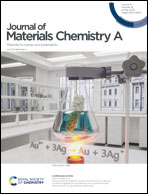Promotion of oxygen reduction and evolution by applying a nanoengineered hybrid catalyst on cobalt free electrodes for solid oxide cells†
Abstract
A key requirement for the widespread commercialization of solid oxide cell (SOC) technology is to develop cost-effective oxygen electrodes with sufficiently high electro-catalytic activity and durability at intermediate temperatures (600–750 °C). Here we report a remarkable enhancement of electro-catalytic activity of cobalt-free (La0.6Sr0.4)0.98FeO3−δ (LSF) electrodes by applying a nanoengineered hybrid catalyst coating composed of nanoparticles of Ce0.85Gd0.15O2−δ (CGO) and Pr6O11via co-infiltration. Different from the conventional infiltration with a precursor of metal nitrate, here a mixture solution of colloidal CGO nanocrystals and Pr(NO3)3 is used for infiltration to enable the desired nanoengineered architecture. The resulting hybrid-catalyst-coated LSF electrode exhibits a very low polarization resistance of 0.017 Ω cm2 at 750 °C, about one order of magnitude lower than that of bare LSF (0.197 Ω cm2). Furthermore, the Ni/yttria-stabilized zirconia (YSZ) fuel-electrode-supported cell with this hybrid-catalyst-coated LSF electrode displays excellent performance in both fuel-cell and electrolysis operations, while it also offers good durability tracked over 1000 h of fuel-cell operation. The unique catalytic activity of the hybrid-catalyst-coated LSF electrode is attributed to the combined effects of accelerating oxygen surface exchange kinetics by Pr6O11 and enhancing the available surface area by the nanoporous architecture of the catalyst coating. Moreover, combined with the modification of the Ni/YSZ electrode, stable electrolysis operation at 650 °C under −0.5 A cm−2 with a voltage close to 1.3 V is achieved on a cell prepared without cobalt. This work not only opens the opportunity for applying cobalt-free oxygen electrodes in SOCs but also proposes a co-infiltration strategy to develop a highly active and robust catalyst coating by combined tuning of composition and morphology, which may also be applicable to other devices such as metal–air batteries and membrane reactors.



 Please wait while we load your content...
Please wait while we load your content...